Catalogue > List by artist
Browse the entire list of Rencontre Internationales artists since 2004. Use the alphabetical filter to refine your search. update in progress
Eai
Catalogue : 2007Digital Video Effect: New Video from the EAI Colle | 0 | 0 | | 62:0 | USA | 2007

Eai
Digital Video Effect: New Video from the EAI Colle
0 | 0 | | 62:0 | USA | 2007
This program of videos new to the EAI collection includes work by artists with very different histories and creative strategies. Seoungho Cho's "Snap" (2006) continues his exploration of minimalist and dynamically visual video art. Michael Snow's "WVLNT" (2003) is a highly conceptual video reworking of his influential experimental film "Wavelength" (1967). Seth Price's "Digital Video Effect: "Editions" (2006) is a witty and engaging edit of excerpts from his editioned video works. Finally, Sophie Calle and Fabio Balducci's "Unfinished" (2005) is a revealing and humorous investigation of the artistic process.
EAI (Electronic Arts Intermix), New York was established in 1971 to promote video as an art form. EAI's distribution collection developed from tapes being made by video art pioneers, many of whom were based in New York at that time. Some videos were produced at the editing facilities, or exhibited at EAI supported events. The collection, which now spans the mid-1960s to the present, comprises almost 3,000 tapes and 200 artists, including performance based and conceptual works, experimental narratives, cultural essays, subjective documentaries, and technical explorations. EAI distributes works by distinguished artists who are essential figures in the history of video as an art form, such as Nam June Paik, Bill Viola, Dara Birnbaum, and Joan Jonas. Recent additions to the collection have been video works by experimental filmmakers such as Carolee Schneemann, Ken Jacobs, and Michael Snow, and cutting edge conceptual and new media artists, such as Cory Arcangel and Seth Price.
Veronika Eberhart
Catalogue : 2023Garten sprengen | Experimental doc. | 16mm | color | 12:0 | Austria | 2022
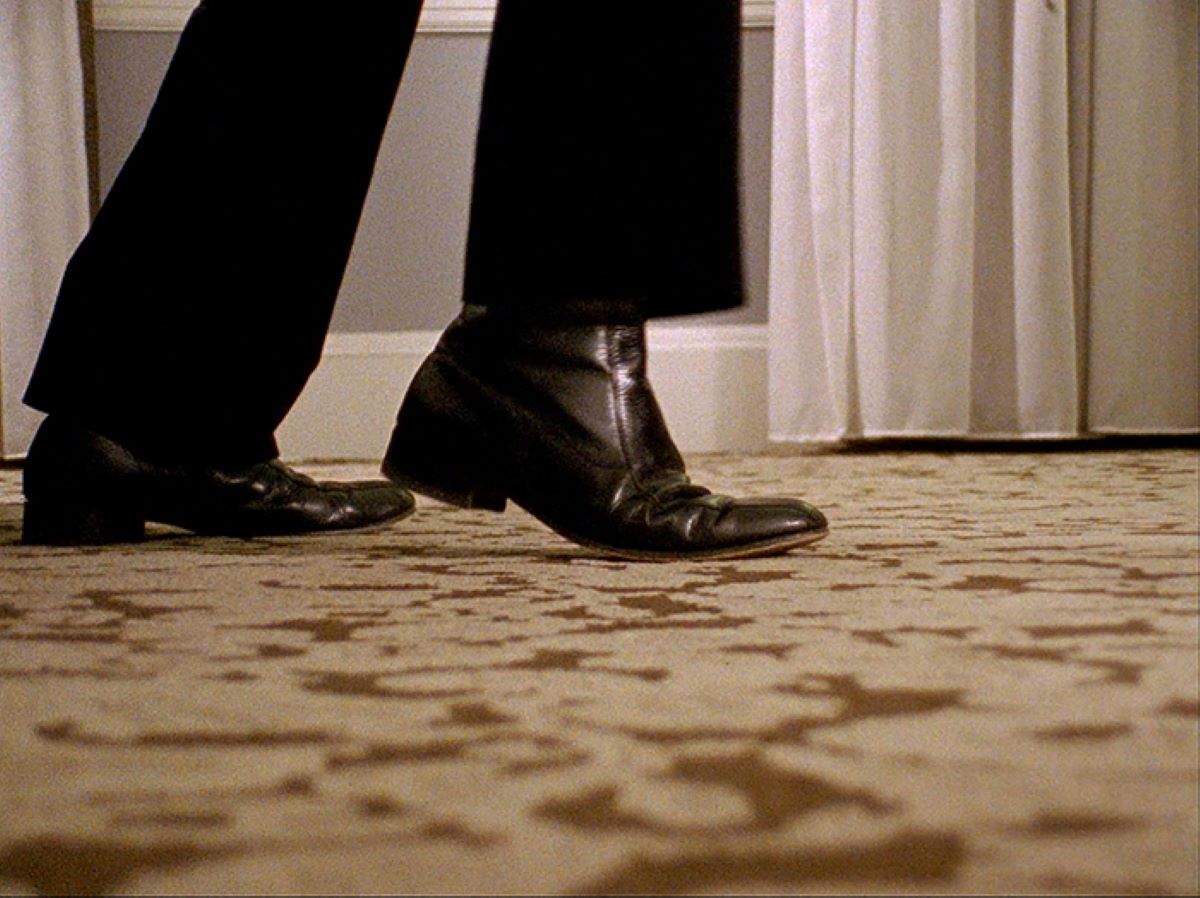
Veronika Eberhart
Garten sprengen
Experimental doc. | 16mm | color | 12:0 | Austria | 2022
“Are you familiar with American poetry?” The question sounds like an accusation as posed by Hanns Eisler in a heavy German accent during his interrogation in 1947 by the House Committee on Un-American Activities. Simultaneously Veronika Eberhart's GARTEN SPRENGEN shows a man (performer: Ian F Svenonius) wandering down a virtually endless hotel corridor. Yet it is the elaborate blue, yellow and cream colored pattern of the hotel's carpet floor that sticks out. Its haptic quality becomes directly translated into imagery during a different montage sequence: a hand sensitively glides along a window ledge, another likewise touches the neck of a guitar, and a third caresses the armrest of a sofa. These images attempt to grasp the ghosts of an historical place, specifically the Biltmore Hotel in downtown Los Angeles. This previous site of the Academy Awards was also where Eisler's hearing at the beginning of the McCarthy era took place... more info: https://www.sixpackfilm.com/en/catalogue/2787/
Visual artist, filmmaker and musician, born 1982 in Bad Radkersburg. Studied sociology in Vienna and Copenhagen, visual arts at the Academy of Fine Arts Vienna and at the Friedl Kubelka School for independent film, Vienna. Various exhibitions and film festivals, most recently at Mackey Garage Top, MAK Center, Los Angeles (2020), Kunsthalle Vienna (2019), Kharkiv Municipal Gallery (2019), New Jörg, Vienna (2019), Kunsthalle Exnergasse, Vienna (2018), rotor Graz (2018), Bazament Art Space, Tirana (2018), A-GALLERY, Tokyo (2017)
Juan Manuel Echavarria
Catalogue : 2007Bocas de Ceniza | Experimental doc. | dv | color | 22:0 | Colombia | 2004
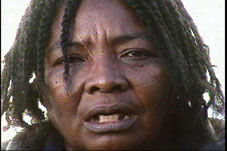
Juan Manuel Echavarria
Bocas de Ceniza
Experimental doc. | dv | color | 22:0 | Colombia | 2004
Seven Colombians, victims of the violence in their country, sing songs, composed by them, in response to their experiences.
Juan Manuel Echavarría was born in Medellin, Colombia in 1947. After the publication of his novels and short stories, he stopped writing. The Colombian society being dominated by violence and power continually enlarging its drug cartel, he was frustrated by the disintegration of Columbian life and by the social isolation necessary for writing. He started his photographic work by moving towards the exploitation metaphoric possibilities of the photographic image. Echavarria's art aims at arousing a grasp of conscience, of transcending the generalized violence of the Columbian society. The question of the representation of this violence is the pivot around which his work is constructed. He gives a dignity to the victims of the civil war's extremely violent conflict. The conflicts between the army, the leftist guerrilla, and the paramilitaries of the right can be traced back to the 50's, and the drug cartels back to the 80's. Each successive brutal cycle transmits a national psychosis of violence to the country, a state of mind in which the omnipresent carnage and fear are natural states of existence. Juan Manuel Echavarria's beautiful disturbing images evoke the fear and the human loss in this endless war, but without presenting bleeding bodies. These recurrent photographs display men and women, abandoned villages, and their melancholic objects. Grotesque but not horrible reinterpretations of botanic patterns and a dramatization of rituals, that are particular to the Columbian heritage, surround the dead. His work has been shown at the Irish Museum of Modern Art, Dublin; the Languedoc-Roussillon Regional Centre of Contemporary Art in Sète, France; the New York Museum of Modern Art; the 51st Venice Biennial; the Buenos Aires Modern Art Museum; EMAF Ossnabruck in Germany; the Bogota Modern Art museum; the Kwangju Biennial in Korea, the Reina Sofia Museum in Madrid; and the Oberhausen Film Festival.
Catalogue : 2007Bandeja de Bolivar | Experimental video | dv | color | 3:58 | Colombia | 2004
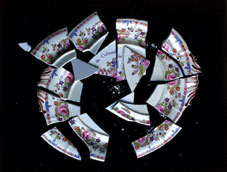
Juan Manuel Echavarria
Bandeja de Bolivar
Experimental video | dv | color | 3:58 | Colombia | 2004
To commemorate Columbia's independance from the Spanish Crown, Simon Bolivar orders a porcelain serving plate bearing the inscription "'Republica de Colombia para siempre" (Republic of Columbia forever). "Bandeja de Bolivar" is a series of photographs and a video that documents the destruction of a replicate of this plate that, in the final image, reveals a mound of white powder, easily identifiable as cocaine. Over these last years, Columbia has suffered from violence supplied by the trafficking of cocaine. This violence, which does not seem to have an end, where the guerrillas supervise the traffic and the production. The profits of this illegal business are enormous and the guerrillas have become extremely powerful, forcing the Columbian government to guarantee them an extension of territory to enter into discussions for peace. The government is absent from this territory. In this video, the artist searches to show what came to Bolivar's ideal.
Juan Manuel Echavarría was born in Medellin, Colombia in 1947. After the publication of his novels and short stories, he stopped writing. The Colombian society being dominated by violence and power continually enlarging its drug cartel, he was frustrated by the disintegration of Columbian life and by the social isolation necessary for writing. He started his photographic work by moving towards the exploitation metaphoric possibilities of the photographic image. Echavarria's art aims at arousing a grasp of conscience, of transcending the generalized violence of the Columbian society. The question of the representation of this violence is the pivot around which his work is constructed. He gives a dignity to the victims of the civil war's extremely violent conflict. The conflicts between the army, the leftist guerrilla, and the paramilitaries of the right can be traced back to the 50's, and the drug cartels back to the 80's. Each successive brutal cycle transmits a national psychosis of violence to the country, a state of mind in which the omnipresent carnage and fear are natural states of existence. Juan Manuel Echavarria's beautiful disturbing images evoke the fear and the human loss in this endless war, but without presenting bleeding bodies. These recurrent photographs display men and women, abandoned villages, and their melancholic objects. Grotesque but not horrible reinterpretations of botanic patterns and a dramatization of rituals, that are particular to the Columbian heritage, surround the dead. His work has been shown at the Irish Museum of Modern Art, Dublin; the Languedoc-Roussillon Regional Centre of Contemporary Art in Sète, France; the New York Museum of Modern Art; the 51st Venice Biennial; the Buenos Aires Modern Art Museum; EMAF Ossnabruck in Germany; the Bogota Modern Art museum; the Kwangju Biennial in Korea, the Reina Sofia Museum in Madrid; and the Oberhausen Film Festival.
Catalogue : 2007Guerry y pa | Experimental video | dv | color | 8:52 | Colombia | 2004
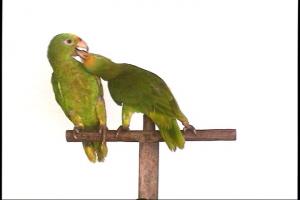
Juan Manuel Echavarria
Guerry y pa
Experimental video | dv | color | 8:52 | Colombia | 2004
"Guerra y Pa" films two parrots for nine minutes. Each one of them has learned to repeat the word "Guerra" for one and "Pa" for the other. Settled in on their perch, they fight and argue in a parody of politicians and guerrillas as when they speak publicly on the question of Columbia's peace and war.
Juan Manuel Echavarría was born in Medellin, Colombia in 1947. After the publication of his novels and short stories, he stopped writing. The Colombian society being dominated by violence and power continually enlarging its drug cartel, he was frustrated by the disintegration of Columbian life and by the social isolation necessary for writing. He started his photographic work by moving towards the exploitation metaphoric possibilities of the photographic image. Echavarria's art aims at arousing a grasp of conscience, of transcending the generalized violence of the Columbian society. The question of the representation of this violence is the pivot around which his work is constructed. He gives a dignity to the victims of the civil war's extremely violent conflict. The conflicts between the army, the leftist guerrilla, and the paramilitaries of the right can be traced back to the 50's, and the drug cartels back to the 80's. Each successive brutal cycle transmits a national psychosis of violence to the country, a state of mind in which the omnipresent carnage and fear are natural states of existence. Juan Manuel Echavarria's beautiful disturbing images evoke the fear and the human loss in this endless war, but without presenting bleeding bodies. These recurrent photographs display men and women, abandoned villages, and their melancholic objects. Grotesque but not horrible reinterpretations of botanic patterns and a dramatization of rituals, that are particular to the Columbian heritage, surround the dead. His work has been shown at the Irish Museum of Modern Art, Dublin; the Languedoc-Roussillon Regional Centre of Contemporary Art in Sète, France; the New York Museum of Modern Art; the 51st Venice Biennial; the Buenos Aires Modern Art Museum; EMAF Ossnabruck in Germany; the Bogota Modern Art museum; the Kwangju Biennial in Korea, the Reina Sofia Museum in Madrid; and the Oberhausen Film Festival.
Juan Manuel Echavarria Olano
Catalogue : 2014Requiem NN | Documentary | hdcam | color | 67:22 | Colombia | 2013
Juan Manuel Echavarria Olano
Requiem NN
Documentary | hdcam | color | 67:22 | Colombia | 2013
RÉQUIEM NN is a film about a ritual of resistance of the people of Puerto Berrío, Colombia ? people who have lived continuous cycles of violence for many decades. The recovery of bodies from the Magdalena River,their burial, the favors local townspeople ask of the souls of the NN (No Names), and the baptism of these unknown corpses is a collective ritual that has taken place for over 30 years.
JUAN MANUEL ECHAVARRÍA was born in Medellín in 1947. He wrote two books, "La Gran Catarata" (1981) and "Moros en la Costa" (1991), before turning to photography in 1996 when he began to investigate the violence in Colombia through art. His photographs have been exhibited in different museums in Colombia and in towns like Mampuján (Bolívar) and Puerto Berrío (Antioquia). Internationally he has shown his work in many different places such as the Biennale of Sydney, Australia (2012); the Venice Biennale, Italy (2005); the Mois de la Photo, Montreal, Canada (2011); Kumu Art Museum in Tallinn, Estonia (2011); Museum of North Dakota, Grand Forks, USA (2005); among others. "La Bandeja de Bolívar: 1999? was his first video; then "Guerra y Pa" (2001) and "Bocas de Ceniza" in 2003. His videos have been featured in the Robert Flaherty Film Seminar, USA (2009), the Musée du Jeu de Pomme, Paris (2006); MOMA, New York, USA (2005) and many more. From 2006 to 2012 he worked on "Novenarios en espera", showing the transformation through time of the NN tombs of Puerto Berrío. "Réquiem NN" (2013) is his first film.
Juan Manuel Echavarría
Catalogue : 2016Silencio Invisible, Darwin and Una Lección | Video | hdv | color | 8:0 | Colombia | 2015
Juan Manuel EchavarrÍa
Silencio Invisible, Darwin and Una Lección
Video | hdv | color | 8:0 | Colombia | 2015
Juan Manuel Echavarría parle de la guerre qui échappe au regard, dans les territoires reculés de Colombie. Les lieux, vides de toute présence humaine, évoquent l’histoire violente du pays et l’impératif de nouveaux possibles. Jussie Nsana Banimba interroge la mémoire des murs de Brazzaville, qui deviennent des espaces témoins, entre le passé et le présent. Dominik Ritszel place le son comme protagoniste principal de son film, dans une ville devenue laboratoire de perception où la civilisation est en suspens. Hans Op de Beeck crée un film d’animation à partir de ses aquarelles, introduisant un degré de fiction supplémentaire dans ce qui n’est jamais la reproduction d’une réalité. Mike Hoolboom reprend les images filmées en 1967 par Jeffrey Paull, dans un hôpital psychiatrique. Cinquante ans plus tard, il interroge Donna Washington, autiste et pensionnaire de cet hôpital à l’époque, qui raconte sa propre histoire à partir des images du film.
Ricardo Echevarría
Catalogue : 2007AVAM | 0 | 0 | | 0:0 | Spain | 2007
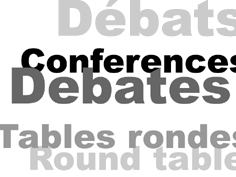
Ricardo EchevarrÍa
AVAM
0 | 0 | | 0:0 | Spain | 2007
The AVAM, Associated Visual Artists of Madrid, is a professional association which represents the artists living in Madrid. It acts as a representative and talks on behalf of the visual artists before local and autonomous administrations. It protects artists and their artwork and works on obtaining a better support to creation, education and diffusion of visual arts. The AVAM belongs to the Cultural Council of the Community of Madrid and is a member of the UAAV, an Association uniting visual artists and gathering the professional associations of the various autonomous communities, and which currently boasts about 3,500 partnerships. The AVAM also belongs in the the EVAN, European Visual Artists Network, through the UUAV. The AVAM works democratically, structured around two organisms, the General Assembly of partners and the Board of Directors, currently made up with 19 members, and delegated by the Assembly in the direction, administration and representation tasks of the association.
Ricardo Echevarría studied the Fine Arts, music and architecture at the Arts School of Cuenca, at the Professional Music Conservatory of Cuenca and the Menéndez Pelayo University. His artwork has been widely shown at the occasion of individual and collective exhibitions, in Spain and Europe. His work has been granted with several awards and scholarships.
Clemencia Echeverri
Catalogue : 2015Supervivencias | Video | hdv | color | 11:21 | Colombia | 2013
Clemencia Echeverri
Supervivencias
Video | hdv | color | 11:21 | Colombia | 2013
Supervivencias (Survivals) is a multichannel video installation that merges from an investigation I made of political distances in our Colombian territory. I took multiple journeys through the country, in order to hear the pulsating beats of a territory that has experienced the conflict, controversies and discords for many years; in order to sense how a land gets scorched while being traced by boundaries as well as crossroads, and how that stories, histories get calcined. This piece– executed on the basis of their own rhythm, forces and times – betoken vital ferments, trepidations and a foreboding darkness. Sol Astrid Giraldo a Colombian art critic wrote about Supervivencias " The land cannot be tranquil in the wake of sacrifices: It is a restless land, plowed by presences as much as it is by absences, limited not only by physical boundaries of blood and fire but by invisible ones as well, of added terrors and secrets. Such is the land of war, which won´t fit in with pacifier narratives. How can it be named then? How can it be made visible?".In Supervivencias a house emerges with its atavistic symbolism in full display: doors opening and closing, corridors leading who knows where inscrutable nooks and corners. Then, finally, an invasion of ghostly, overflowing presences, The ancestral house, the sheltering one, the dwelling and the refuge is now ridden with porosities that cannot curb the exterior pressure.” www.clemenciaecheverri.com
BIO Clemencia Echeverri lives and works in Bogotá. She got her BA in Fine Arts in Colombia and Masters degree in Fine Arts at Chelsea College of Arts, London. She has worked as an arts professor in Colombia. Having dedicated herself to sculpture and painting until the mid-nineties, Clemencia started to work on installation, video, sound and interactive works inspired by the political and social problems that have marked her time. At the moment she is preparing Nóctulo, for Nce–Arte in Bogotá (2015). Relevant and recent works: Treno/ Waterweavers curated by José Roca, at Bard Graduate Center New York.(2014) Sacrificio at the I International Bienal de Arte in Cartagena, and at 43 Salon (inter Nacional de Artistas)Curated by Gabriela Rangel, Medellin (2013-2014). Supervivencias at Alonso Garcés Gallery and Versión Libre (nominatedin the VI Luis Caballero award (2011) The Liverpool Biennial (2010)No longer empty sound project. CENART Mexico (2011) Cosmovideografías Latinoamericanas. A solo site specific show at Museo Nacional de Colombia. Biennal de la Habana (2000), Bienal de Bogotá 1998. Treno at Daros-Latinamerica Museum, Zurich (2009); Don’t Stare at the sun in Poland; Galeria GAK Bremen. Electronic arts festivals such as ISEA in Helsinki-Stockholm and Tallin; Artes Electrónicas Banquete in Madrid; Ars Electronica in Austria; international fellowships such as those given by Yadoo, arts residency in New York, The Arts Council, London; Canada’s Daniel Langlois Foundation; and the Bienal de las Artes award in Colombia. Collections; Daros–Latinamerica National Bank in Colombia, Los Angeles (MOLAA); the Museo MEIAC, Spain; the Essex Latin American Collection,England, as well as by a number of private collectors. www.clemenciaecheverri.com
Leon Eckard, Nathalie Brum
Catalogue : 2022Toter Winkel | Experimental VR | 0 | | 0:0 | Germany | 2020
Leon Eckard, Nathalie Brum
Toter Winkel
Experimental VR | 0 | | 0:0 | Germany | 2020
The Virtual Reality soundwalk Toter Winkel by media artist Leon Eckard (idea and implementation) and architect and sound artist Nathalie Brum (architecture) plays with spatial and acoustic paradoxes that reveal our – often deceptive – perception. The space and sound of the soundwalk are inspired by Dutch graphic artist M. C. Escher, English mathematician and theoretical physicist Roger Penrose and American cognitive scientist Roger Shepard. Its an ever ongoing cycle, which gives the illusion of a continuous tunnel, whereby the reflection about it reveals its paradox nature. The audiences for this VR work can move interactively through the virtual space and see whether they discover the blind spot. Deceptive perceptions can be found everywhere in human perception, and so Leon Eckard argues in his project that we should constantly question our own blind spot.
Teboho Edkins
Catalogue : 2007My Gangsta Project | Experimental fiction | dv | color | 9:0 | South Africa | 2006

Teboho Edkins
My Gangsta Project
Experimental fiction | dv | color | 9:0 | South Africa | 2006
Starting in January 2006, the artist spent two months with Jackals and their friend in a Ghetto outside of Cape Town, South Africa. He had always wanted to make a Gangster film (something like a real life MTV gangster Rap clip). Full of expectations he hired a sleek car and organized a casting in Paris for a suitably sexy dancer. What makes a gangster, it seems, is a context of poverty and violence, and this film became rather violent, and while he was filming a reality, it is not a documentary.
Teboho Edkins was born in the USA, grew up in Lesotho, Germany, and South Africa, and is currently studying at le Fresnoy, Studio National des arts contemporains, in France. He has made four films to date, "Ask me I am positive", "Looking Good", "True Love" and what he calls his "First Gangsta Project". At the moment he is working on another film with Gangsters in the Cape and will be moving to Berlin in September.
Teboho Joscha Edkins
Catalogue : 2015Gangster Backstage | Documentary | hdv | color | 37:30 | South Africa | 2013
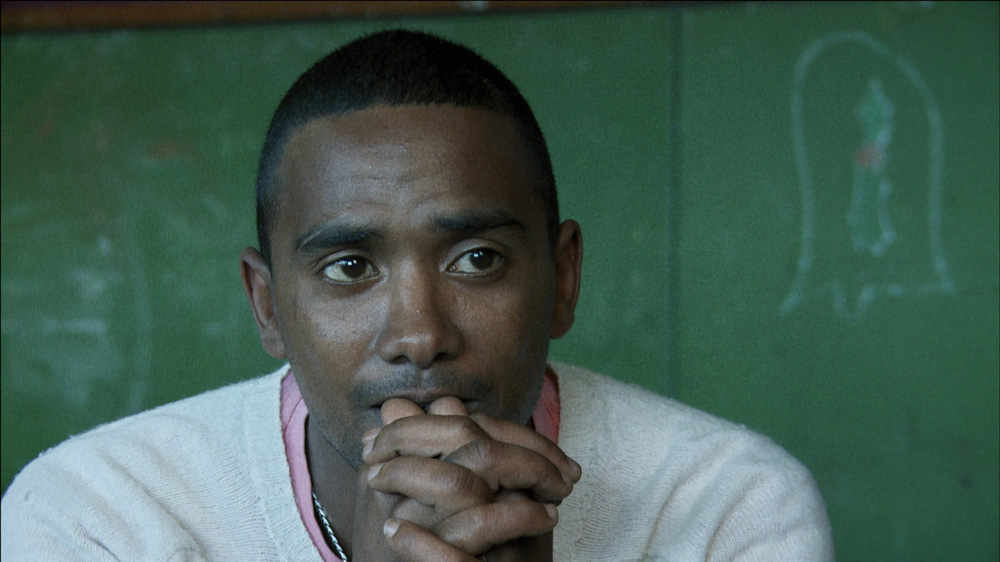
Teboho Joscha Edkins
Gangster Backstage
Documentary | hdv | color | 37:30 | South Africa | 2013
Gangster Backstage is a documentary film with gangsters in Cape Town, South Africa. As the film moves between a casting interview and scenes in an empty theatre, the sense of confinement within the space increases and becomes a feeling of being trapped, a square, boundaries, a sort of purgatory, the tempo of cigarettes, not knowing where the soul goes, fear, caught in one's thoughts, wanting to break free but can't… a cell.
Teboho Edkins was born in the USA in 1980 and grew up mainly in Lesotho, South Africa but also in Germany. He studied Fine Art at the University of Cape Town, followed by a 2-year post-graduate residency at le Fresnoy, studio national des arts contemporains in France and then a post-graduate film directing programme at the dffb film academy in Berlin.
Teboho Joscha Edkins
Catalogue : 2023Ghost | Experimental doc. | 4k | color | 8:41 | South Africa | 2023
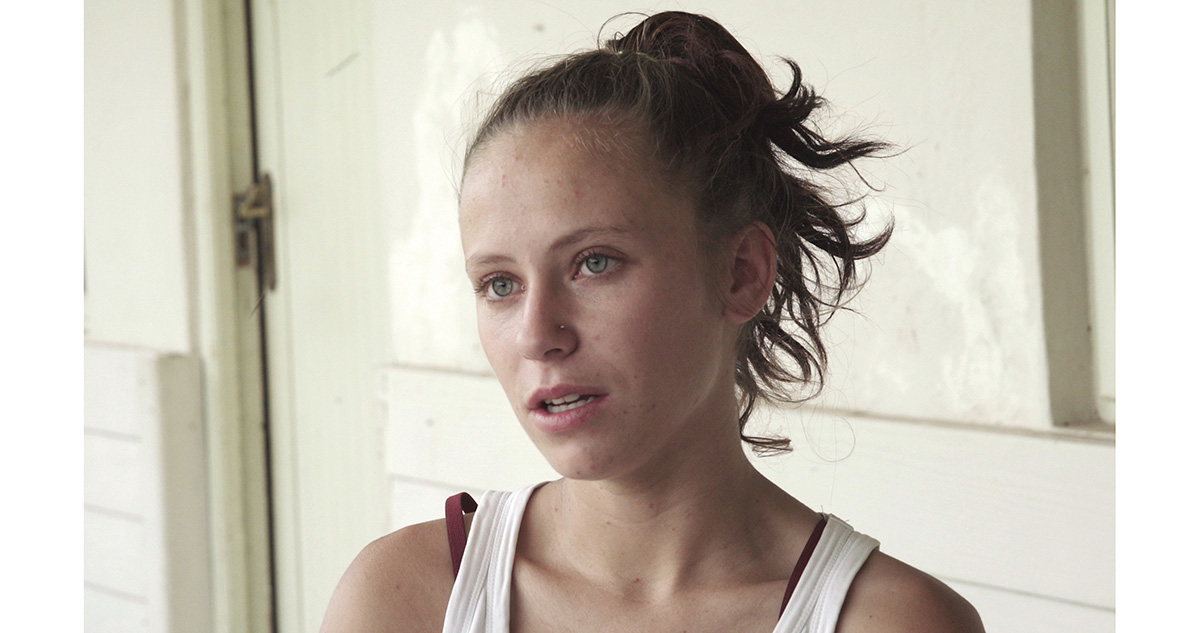
Teboho Joscha Edkins
Ghost
Experimental doc. | 4k | color | 8:41 | South Africa | 2023
Ghosts is a short documentary film, in which ghosts, both real and imagined, haunt the lives of a rural community, in their small town in post-apartheid South Africa.
Teboho Edkins (*1980 in Tennessee, USA) grew up in Southern Africa and lives and works in Cape Town and Berlin. He studied photography and fine art at the Michaelis School of Fine Art, University of Cape Town, South Africa and film at Le Fresnoy Studio National des Arts Contemporains in Tourcoing, France. This was followed by a degree in directing at the Deutsche Film und Fernseh-akademie in Berlin (dffb). Teboho Edkins’s films have shown at many festivals, group and solo exhibitions, including at the Centre Pompidou, Paris; Tate Modern, London; South London Gallery; Haus der Kulturen der Welt, Berlin; Museum für Moderne Kunst, Frankfurt; Berlinische Galerie, Berlin; Weserburg-Museum für Moderne Kunst, Bremen; Museum of Modern Art, New York City. Some of the over 500 film festivals his films have screened at include the International Film Festival Berlin (Berlinale); International Short Film Festival, Oberhausen; and International Film Festival (IFFR), Rotterdam. His films have also been acquired by several public and private art collections including the Goetz Collection in Munich, von Kelternborn Collection in Frankfurt and the Collection KAI 10 | Arthena Foundation in Düsseldorf.
Catalogue : 2017Initiation | Documentary | 4k | color | 10:47 | South Africa | 2016
Teboho Joscha Edkins
Initiation
Documentary | 4k | color | 10:47 | South Africa | 2016
High in the mountains of Lesotho, Mosaku is anxiously awaiting the return of his older brother from an initiation ceremony. The initiates spend 5 months in a remote secrete location. When the boys return, they are grown men.
Teboho Edkins was born in the USA in 1980 and grew up in Lesotho, South Africa and also in Germany. He studied Fine Art at the University of Cape Town, followed by a 2-year post-graduate residency at le Fresnoy, studio national des arts contemporains in France and then a post-graduate film directing program at the dffb film academy in Berlin. His films show at film festivals, television, museums, win awards and have been acquired by private art collections. He currently lives between Berlin and Cape Town.
Catalogue : 2012Gangster Project | Experimental fiction | 0 | color | 56:0 | South Africa | 2011

Teboho Joscha Edkins
Gangster Project
Experimental fiction | 0 | color | 56:0 | South Africa | 2011
In Cape Town, South Africa, one of the world`s most violent and unequal societies, a young white film student sets out with his cameraman, leaving the comfort of his protected neighbourhood. He wants to make a Gangster Film, with real gangsters. After a lengthy search for a suitably `cinematic` character, he finds the perfect gang and settles into their everyday rhythm. The reality soon catches up and the claustrophobic gangster life doesn?t exactly fit to the expectations. 20 year after the first democratic election, South Africa remains a deeply divided society, one in which dialogue and understanding seem impossible, out of reach. It is a film between fiction and reality, where real truths are revealed and fiction stops being fiction, and when it stops mattering.
Teboho Edkins was born in the USA in 1980 and grew up mainly in Lesotho, but also Germany, South Africa, France and now lives in Berlin. He studied Fine Art at the University of Cape Town, followed by a 2-year post-graduate residency at le Fresnoy, studio national des arts contemporains in France and then a post-graduate film directing programme at the dffb film academy in Berlin. His films have been screened in over 100 festivals and galleries worldwide.
Catalogue : 2009Kinshasa 2.0 | Documentary | 16mm | color | 11:7 | South Africa | 2008
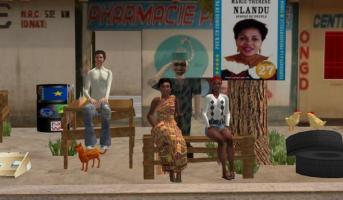
Teboho Joscha Edkins
Kinshasa 2.0
Documentary | 16mm | color | 11:7 | South Africa | 2008
An Internet campaign helps in the release of a presidential candidate jailed for talking openly about the lack of democracy. Moving between a militarised Kinshasa and Second Life, (a 3D virtual chat program), the subversive power of the Internet for democracy is explored whilst painting a disquieting portrait of an African Capital.
Teboho Edkins was born in the USA in 1980 and grew up in mainly in Lesotho, but also Germany, South Africa and France and now lives in Berlin. He studied Fine Art in Cape Town, did a 2-year post-graduate residency at le Fresnoy, studio national des arts contemporains in France, and is currently in the post-graduate programme of the dffb film academy in Berlin. He has received numerous scholarships and prizes.
- Edwin, -
Jussi Eerola
Catalogue : 2023Grasshopper | Experimental film | 4k | color | 9:0 | Finland | 2023
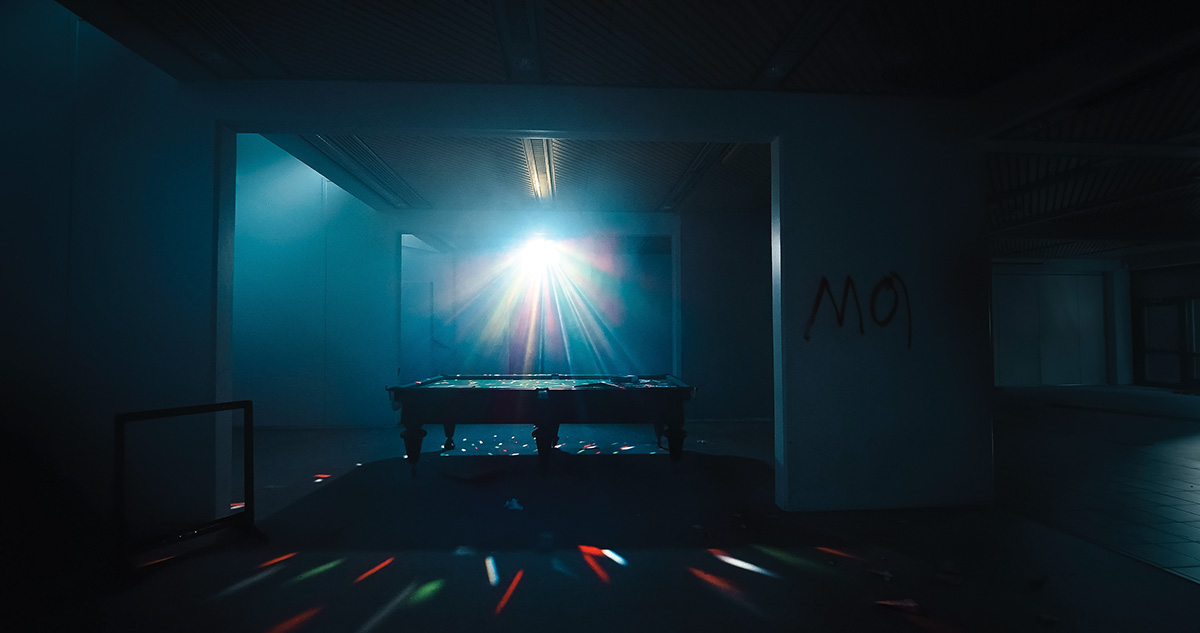
Jussi Eerola
Grasshopper
Experimental film | 4k | color | 9:0 | Finland | 2023
During the darkest hours of the night a small disco light appears and shines lights to empty business premises. A minimalistic musical.
Jussi Eerola has worked as a cinematographer on many internationally awarded films since 1992. His directional debut was a documentary about electro-hypersensitive people titled Refugees of Technocracy (2009). The Return of the Atom directed together with Mika Taanila premiered at TIFF 2015 and won the NORDIC:DOX Award at CPH:DOX in 2015. Eerola’s first minimalistic short film Blue Honda Civic premiered at IFFR in 2020 and continued to many international festivals receiving three awards. Eerola is a founding member of the production company Testifilmi Oy started 2014 together with Mika Taanila and visual artist duo IC-98 (Patrik Söderlund and Visa Suonpää). Testifilmi emphasizes the vast potential of cinematic possibilities over standard formats and storytelling.
Jussi Eerola
Catalogue : 2022Obsidian Blue Pearl | Video | 4k | color | 11:3 | Finland | 2021
Jussi Eerola
Obsidian Blue Pearl
Video | 4k | color | 11:3 | Finland | 2021
The romantic landscape paintings often portrayed weather condition, topography of national landscape, religious themes, spirituality of nature and hunting scenes. Obsidian Blue Pearl is a minimalistic road movie mirroring the emotions of the driver through the landscapes (s)he has chosen to look at.
Jussi Eerola (b.1969) has worked as a cinematographer on many internationally rewarded short films, documentaries and tv-features since 1992. He has collaborated with many visual artist’s e.g. Eija-Liisa Ahtila, Mika Taanila, IC-98, Elena Näsänen and Anu Pennanen. His directional debut was a documentary about electro-hypersensitive people titled Refugees of Technocracy (2009). Documentary film The Return of the Atom written & directed together with Mika Taanila premiered at Toronto IFF 2015 and was given the NORDIC:DOX award at CPH:DOX in 2015. In 2014 he started a production company Testifilmi Oy together with Mika Taanila and visual artist duo IC-98 (Patrik Söderlund and Visa Suonpää) and has produced several of company's films. Eerola's first short film Blue Honda Civic (2020) premiered at IFF Rotterdam and was awarded three times at international film festivals.
Effi & Amir
Catalogue : 2022Places of Articulation: Five Obstructions | Experimental doc. | mov | color | 22:0 | Belgium | 2020
Effi & Amir
Places of Articulation: Five Obstructions
Experimental doc. | mov | color | 22:0 | Belgium | 2020
Places of Articulation: Five Obstructions takes the spectator on a journey across borders, from Northern Ireland to Tibet, passing through Germany, Albania and Flanders. However, it explores a more deeply engraved border, the invisible border of our oral cavity, which marks and defines the sounds we can emit and the words we can pronounce. Since biblical times and up till nowadays asylum procedures, this border is exploited to discriminate and divide. Moving between territories – sonic, anatomical and political ones – this installation examines how voice and pronunciation are used as identifiers, eventually become mobile checkpoints, determining fates and sometimes costing lives. Employing different imaging methods and visualisations, it renders these checkpoints visible, while questioning the limits of identification and revealing blurred lines or zones of ambiguity that defy binary categorisation.
Effi & Amir, born and raised in Israel, are working as a duo since 1999 and have been living in Brussels since 2005. They studied fine arts at the Bezalel Academy, Jerusalem and The Sandberg Institut, Amsterdam and taught themselves, much later, how to make films. Their work, which employs audiovisual media, performance and participatory strategies, is located on the blurry border between documentary and fiction, and is dealing with mechanisms of construction – of identity, group belonging, history and the artwork itself. Effi & Amir's work was recently awarded prizes in documentary film festivals (docAviv, IndieLisboa, En ville !, Jean rouch festival) and they are laureates of the Scam's 2022 Prix de parcours for audiovisual documentary work.
Ewa Effiom
Catalogue : 2026WHEN ONE DOOR OPENS | Experimental doc. | mp4 | color | 10:44 | Belgium, United Kingdom | 2024
Ewa Effiom
WHEN ONE DOOR OPENS
Experimental doc. | mp4 | color | 10:44 | Belgium, United Kingdom | 2024
WHEN ONE DOOR OPENS emerges as an exploration of the intricate dynamics between authorship, representation, and history. Drawing inspiration from the groundbreaking methodologies of Arthur Jafa and the evocative aesthetics of Christian Marclay. Eschewing from the conventional confines of mainstream cinema, the filmwork delves deep into the rich tapestry of found footage, excavating and appropriating the untold narratives embedded within race films predominantly from the period immediately after the pre-Code era. In this respect it presents itself as a counterpoint to established somewhat one-dimensional work of Marclay. Through a, seemingly circuitous, narrative lens, WHEN ONE DOOR OPENS challenges conventional notions of identity and belonging, inviting viewers to confront the complexities of historical representation. Each frame serves as a portal to a bygone era, where characters navigate through the architectural spaces of both literal and metaphorical significance. The film's exploration of movement within these spaces resonates with profound symbolism, illustrating the transformative power of cinematic storytelling. Ultimately, standing as a testament to the enduring allure of cinema and the implied spaces as a medium for capturing and reimagining the complexities of human experience.
EWA EFFIOM is a London-based Belgo-Nigerian architect, writer and producer. Image Culture, Futurism and Mythology are recurring themes in his work with a focus on their association to space. He was a member of the Architecture Foundation’s New Architecture Writers’ second cohort which culminated in a critically acclaimed public programme and has been published in the Architect’s Newspaper, Dwell, the AJ, ICON, Wallpaper, Frame, OnOffice, Architecture Aujourd'hui, the Modern House magazine, A Daily Dose and Ex Libris amongst others. His piece Architecture, Buildings and Conservation in MAJA was nominated for best piece in the 2022 Estonian Architecture Awards a year after he came second place in the Tallinn Architecture Biennale’s 2021 Curatorial Competition with a proposal entitled Adaptive Re-use. His film Eagle Mansions was premiered at the 2021 Urban Film Festival in Perth and screened at 2022 Melbourne Design Week, before he was awarded the 2022 How To Residency at the Canadian Centre for Architecture entitled “How Not To Be A Developer.” 2022 was also the year that his second film “Beck Road” premiered at the Open City festival before screening at the 18th Venice Architecture Biennale. He was a 2023 LINA Fellow and awarded both the Film Lab residency at the MAXXI Museum in Rome where he made “When One Door Opens” which screened at Demanio Marritimo-278 before being shown at restless architecture exhibition curated by Diller Scofidio and Renfro at the MAXXI Museum. He also took part in the Theatrum Mundi Staging Ground Residency with his collaborative exploration of infrastructural change in Paris in the aftermath of the Olympics. He later returned to LINA to give the State of Architecture Address in 2025 which was met with critical acclaim which was a plea for the archtiecture industry to return to imagination. Though he hasn’t been a lecturer at MA in Architecture + Urbanism at the Manchester School of Architecture since 2022, he is still a visiting critic at the Estonian Institute of Technology and London Metropolitan University.
Anders Eiebakke
Catalogue : 2013Proportional, Integral, Derivative. Registration of an expanding parametre around Kunstnernes Hus | | | color | 7:33 | Norway | 2012

Anders Eiebakke
Proportional, Integral, Derivative. Registration of an expanding parametre around Kunstnernes Hus
| | color | 7:33 | Norway | 2012
.
Born 1970 Lives and works in Oslo In the project "Proportional, Integral, Derivative: Registration of an expanding perimeter around Kunstnernes Hus" I utilise the board´s room in Kunstnernes Hus as a base for drone flying inside and outside of Kunstnernes Hus. The structures and Neo Classicist ideals of the Royal Palace Park create a web programmed into the drone. The Functionalism in Kunstnernes Hus defines the framework of video based piloting.
Charlotte Eifler, Clarissa Thieme
Catalogue : 2023Archival Grid 1 | Experimental doc. | 0 | color | 13:0 | Germany, Bosnia & Herzegovina | 2022
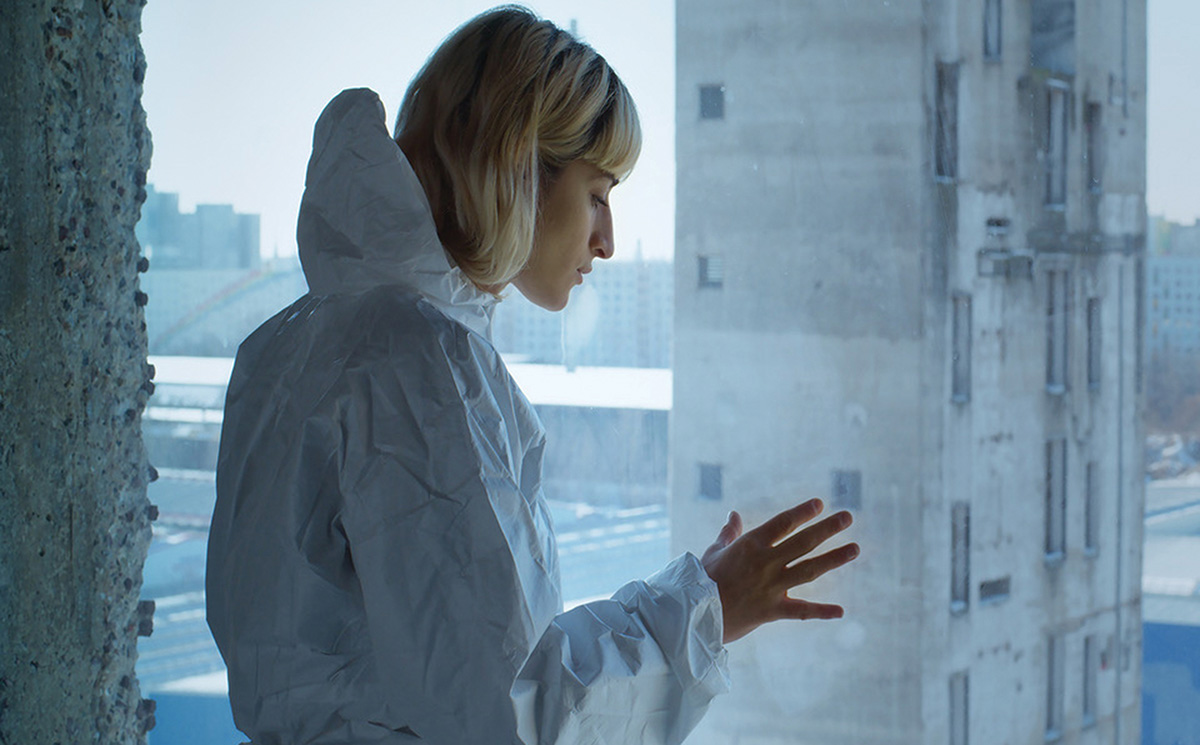
Charlotte Eifler, Clarissa Thieme
Archival Grid 1
Experimental doc. | 0 | color | 13:0 | Germany, Bosnia & Herzegovina | 2022
With the installation ARCHIVAL GRID, Charlotte Eifler and Clarissa Thieme present a filmic analysis in three parts. The work explores the tools of evidence production, the legal impact of cartographic surveys and the social processing of collective traumata and war crimes, as well as the criticism of it by those affected. The source materials are videos from one of the most extensive publicly accessible archives on war crimes: the archive of the International Criminal Tribunal for the former Yugoslavia (ICTY). In 2001, the ICTY conducted site visits with witnesses in Sarajevo to prepare indictments related to the 1992–1996 siege of the city. The purpose of these site visits was the detailed reconstruction of war crimes, particularly the targeted shelling of civilians. Interviews with the local witnesses at the original sites were documented on video, combined with 360-degree photographs and geographical surveys. The first part of ARCHIVAL GRID combines the forensic materials gene- rated from the ICTY evidence documents with transcripts from the court proceedings and interviews conducted today with witnesses and former employees of the ICTY. These recordings of different surveying practices in the fictitious setting of a future archive architecture shape the cinematic discursive framework. This reflects close parallels of perspectives in the technologies of witnessing, evidence and testimony and juxtaposes them with the demands of the affected people for recognition of their suffering. In a second part, ARCHIVAL GRID analyses the historical backdrop of tools of inquiry and their database logic as well as their entanglements with governmentality and coloniality. Algorithms collect data from digital archives and constantly create, combine and re-organize existing and emerg- ing databases. Through historical surveying instruments, maps and globes from the Mathematisch-Physikalischer Salon in Dresden collected und used by the Electors of Saxony, Augustus (1526– 1586) and Augustus II the Strong (1670–1733), Eifler and Thieme reflect on the historic interplay between survey and data collection, its visual representations and absolutistic claims to power. A third part turns once again to the archival ICTY videos to reflect on the specific forms of image production. Juxtaposing the processes and practices of the ICTY film team and the artistic methods that were used in the production of ARCHIVAL GRID, Eifler und Thieme engage with their own positions as filming artists and their role in the interrelation with witnesses of the war.
Charlotte Eifler is an artist and filmmaker spanning performance, video, installation, XR, and sound. Her works address the politics of representation, abstraction, and computation, and are characterized by interdisciplinary forms of collaboration. Focusing on feminist approaches and elements of science fiction, she explores processes of image & history production and imaginations of alternative futures. Charlotte is co-founder and/or member of the networks Digital Critique Leipzig, G-Edit, cobratheater.cobra, FACES – gender,art,technology und feat.Fem. Since Nov 2020, she’s teaching in the department of Media Art/ Film at the Karlsruhe University of Arts and Design (HfG). Eifler’s works have been presented at ACM Siggraph Art, Los Angeles (US); Staatliche Kunsthalle Baden Baden (DE), Le printemps de Septembre, Toulouse (FR); Sapporo International Art Japan (JN); Haus der Kulturen der Welt, Berlin (DE); IMPAKT Utrecht (NL); Kurzfilmtage Oberhausen and RENCONTRES INTERNATIONAL Paris among others. Residencies and scholarships facilitated her research in Moskau (Rosa Luxemburg Foundation), New York (KdFs Foundation) and Mexico City (Institutio Nacional de Bellas Artes y Literatura). /// Clarissa Thieme works with film, performance, text, and installation, combining documentary and fictional methods to explore processes of memory and historical translation as well as their identity implications. For this purpose, Thieme often deals with subjective testimonies in the context of collective traumas and their reconstruction with technical and legal means to trace the fissures that open up between the languages of individual memory and their translation into processes of historical objectification. Her practice is research-oriented and takes a collaborative approach. In series, many of her works link together to form long-term studies that span several years. Since the early 2000s, various artistic projects have taken her to the post-Yugoslav space, where she has collaborated with various archival collections and initiatives.
Jeroen Eisinga
Catalogue : 2014Springtime | Video installation | 35mm | black and white | 19:5 | Netherlands | 2011
Jeroen Eisinga
Springtime
Video installation | 35mm | black and white | 19:5 | Netherlands | 2011
Performance artist Jeroen Eisinga is seated at a small table in front of a wall, which is entirely covered by bees. The pulsating, squirming bee mass gradually covers the artist?s body and face as well. In this gruesome, yet beautifully filmed performance the artist balances on the border between life and death. A claustrophobic image of fearlessness and patience.
Jeroen Eisinga began to work in performance art and film in the early 1990s. He made a series of controversial films in which the idea of suffering and personal danger as artistic expression were central. In his first performance (40-44-PG, 1993) a Volkswagen Beetle without a driver, circles mechanically in circles around the blindfolded artist who walks in circles in the opposite direction. Eisinga`s work deals increasingly with death and transience.
Saara Ekstrom
Catalogue : 2022Shadow Codex | Experimental film | 16mm | color | 12:30 | Finland | 2021
Saara Ekstrom
Shadow Codex
Experimental film | 16mm | color | 12:30 | Finland | 2021
The black-and-white 8mm film of the abandoned facilities of Turku County Prison (1835–2007), documents the layers of messages drawn, scratched and burned on the cell walls. The markings are passages to the shadow of an individual’s psyche, and expose an underbelly which a society simultaneously both generates and hides. The film becomes a codex of a collapsed civilization and evidence of a forbidden zone in the centre of the city. On top of the inmates’ messages, a second layer of graffiti by building squatters, trespassers and other participators has emerged, turning the walls into thickets of obscure visual information and indecipherable communication. The flow of images is punctuated by John Cage’s (1912–1992) composition “Perilous Night” (1964), described as a journey to the nocturnal side of the soul.
Saara Ekström works in film, photography, text and installation. Chronotopes where time and place densify, time that nurtures and erodes, the ambivalent desire to both remember and forget are at the core of her art. Ekström’s work has been shown extensively in various museums and festivals in Europe, the Americas and Asia. She received the Finnish media art prize AVEK-award in 2018 and the prizes of SW Finland in 2017, Finnish Art Society in 1995 and the Aboa prize in 1994. She has been the Helsinki Festival Artist in 2005 and was nominated for both Ars Fennica and Carnegie Art Award prizes in 2010.
Hakima El Djoudi
Catalogue : 20092 avenue M | Experimental fiction | dv | color | 9:14 | France | 2008

Hakima El Djoudi
2 avenue M
Experimental fiction | dv | color | 9:14 | France | 2008
Trough «2 avenue M», Hakima El Djoudi depicts the scenes of implicated conflicts and breakup which looks like passionate but very controlled and elliptic between bourgeois upper class man and woman in a very intensive way. The development of sequence inside of a luxurious apartment without artificial lightings and the dialogie between two characters intensifies the suffocating tension between the man and woman deepened conflicts too late to go back. Manu Park
lives and works in Paris and Corsica